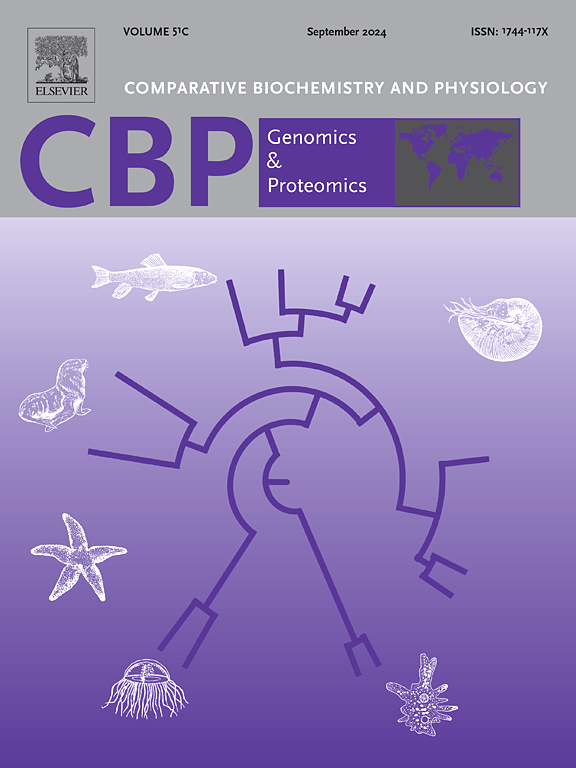High levels of sinigrin trigger synthesis of fatty acids in Plutella xylostella (L.)
IF 2.2
2区 生物学
Q4 BIOCHEMISTRY & MOLECULAR BIOLOGY
Comparative Biochemistry and Physiology D-Genomics & Proteomics
Pub Date : 2025-01-17
DOI:10.1016/j.cbd.2025.101424
引用次数: 0
Abstract
Diamondback moth (Lepidoptera: Plutellidae; Plutella xylostella L.) is a specialist insect of the Brassicaceae family, damaging economically important crops, such as cabbage and cauliflower. Glucosinolates, also known as ‘mustard oil bombs' are present in all Brassicaceae members, of which sinigrin (allyl-glucosinolate or 2-propenyl-glucosinolate) is a major aliphatic compound. During herbivory, glucosinolates are converted to toxic isothiocyanates that deter insect pests. P. xylostella possesses glucosinolate sulfatases that desulfate them. Such a conversion renders them unfit for degradation to toxic products. Changes in the larval performance prompted us for RNA sequencing to understand probable adaptation mechanism under sinigrin stress. Differentially expressed genes were found to be related to larval cuticle proteins. Further, gene ontology and KEGG (Kyoto Encyclopedia of Genes and Genomes) analyses depict genes belonging to the categories, integral component of membrane, cellular processes and those involved in biosynthesis of fatty acids. Upregulation of cuticular genes viz. larval cuticle protein-17 (LCP-17), cuticular protein-19 (2CP-19) and ATP binding cassette transporter C7 (ABCC7), ABCC16 was validated by qRT-PCR. Liquid chromatography quadrupole time of flight mass spectrometry analysis of whole larvae feeding on sinigrin and their separated cuticle, depicted abundance of fatty acids. Changes in the topography of the larval cuticle were evident by scanning electron microscopy. Expression of PxABCH1 was corroborated to its role in the transport of cuticular lipids. Notably, molecular docking of PxABCH1 with cuticular fatty acids showed favorable binding interactions. To summarize, integrated transcriptomic and metabolomic analyses suggest that in response to a diet containing a high dose of sinigrin, P. xylostella re-programs metabolic pathways related to fatty acid biosynthesis that directly influence insect development.

求助全文
约1分钟内获得全文
求助全文
来源期刊
CiteScore
5.10
自引率
3.30%
发文量
69
审稿时长
33 days
期刊介绍:
Comparative Biochemistry & Physiology (CBP) publishes papers in comparative, environmental and evolutionary physiology.
Part D: Genomics and Proteomics (CBPD), focuses on “omics” approaches to physiology, including comparative and functional genomics, metagenomics, transcriptomics, proteomics, metabolomics, and lipidomics. Most studies employ “omics” and/or system biology to test specific hypotheses about molecular and biochemical mechanisms underlying physiological responses to the environment. We encourage papers that address fundamental questions in comparative physiology and biochemistry rather than studies with a focus that is purely technical, methodological or descriptive in nature.

 求助内容:
求助内容: 应助结果提醒方式:
应助结果提醒方式:


